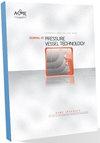往复泵管道系统流体动力相互作用效应的实验与数值研究
IF 1.4
4区 工程技术
Q4 ENGINEERING, MECHANICAL
Journal of Pressure Vessel Technology-Transactions of the Asme
Pub Date : 2023-03-08
DOI:10.1115/1.4057059
引用次数: 0
摘要
往复泵-管道系统的性能往往受到泵、管道和阀门之间流体动力学相互作用的限制。本文通过实验和数值分析对往复泵-管道系统的流体动力特性进行了研究。提出了由往复泵、吸排管路和流量控制阀组成的简易实验平台,并进行了多工况下的往复泵-管路系统流体动力相互作用的实验试验。结合理论分析和CFD仿真,建立了考虑泵阀、柱塞行程和流量控制阀流体动力学相互作用的泵-管道系统动力学模型。预测结果与实验数据吻合较好,并通过实验和数值分析揭示了流体动力相互作用的内在机理和特征。研究表明,管道流体动力学特性对阀门开度滞后和泵阀运动特性有显著影响。流量随柱塞行程的增大呈非线性增大,泄漏量随流量控制阀阻力的增大呈非线性增大。排管压力脉动与控制阀开度和柱塞行程直接相关,并受其显著影响。而储层液位对系统动力学行为的影响相对较小。为往复泵-管道系统的优化设计和运行维护提供参考。本文章由计算机程序翻译,如有差异,请以英文原文为准。
Experimental and Numerical Research On Fluid Dynamic Interaction Effects of Reciprocating Pump-Pipeline System
The performance of a reciprocating pump-pipeline system is often limited by the fluid dynamic interaction between pump, pipeline and valves. In this paper, the fluid dynamic characteristics of a reciprocating pump-pipeline system are investigated via experiments and numerical analysis. A simple experimental platform consisting of a reciprocating pump, suction and discharge pipes and flow control valve are offered and the experimental tests under multi-working conditions are carried out to explore the fluid dynamic interaction of the reciprocating pump-pipeline system. Combined with theoretical analysis and CFD simulations, a dynamic model of the pump-pipeline system is presented with considering the fluid dynamic interaction effect of pump valves, plunger stroke and flow control valve. All of the predicted results coincide well with the experimental data, and the inherent mechanism and the feature of the fluid dynamic interaction are revealed by experiments and numerical analysis. It is shown that the fluid dynamic characteristics of pipeline significantly influence the lag of valve opening and the motion behaviors of pump valves. The discharge flow rate rises nonlinearly with the increase of plunger stroke and the leakage rate associated with the resistance of flow control valve. The pressure pulsation in discharge pipe is directly related to and markedly impacted by the control valve opening and the plunger stroke. However, the influence of the reservoir liquid-level on the system dynamic behavior is relatively slight. This work would give information for the optimum design and operation maintenance of reciprocating pump-pipeline system.
求助全文
通过发布文献求助,成功后即可免费获取论文全文。
去求助
来源期刊
CiteScore
2.10
自引率
10.00%
发文量
77
审稿时长
4.2 months
期刊介绍:
The Journal of Pressure Vessel Technology is the premier publication for the highest-quality research and interpretive reports on the design, analysis, materials, fabrication, construction, inspection, operation, and failure prevention of pressure vessels, piping, pipelines, power and heating boilers, heat exchangers, reaction vessels, pumps, valves, and other pressure and temperature-bearing components, as well as the nondestructive evaluation of critical components in mechanical engineering applications. Not only does the Journal cover all topics dealing with the design and analysis of pressure vessels, piping, and components, but it also contains discussions of their related codes and standards.
Applicable pressure technology areas of interest include: Dynamic and seismic analysis; Equipment qualification; Fabrication; Welding processes and integrity; Operation of vessels and piping; Fatigue and fracture prediction; Finite and boundary element methods; Fluid-structure interaction; High pressure engineering; Elevated temperature analysis and design; Inelastic analysis; Life extension; Lifeline earthquake engineering; PVP materials and their property databases; NDE; safety and reliability; Verification and qualification of software.

 求助内容:
求助内容: 应助结果提醒方式:
应助结果提醒方式:


